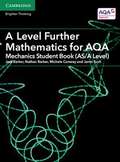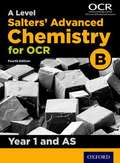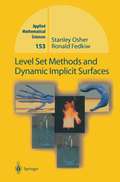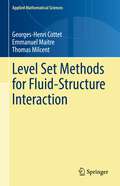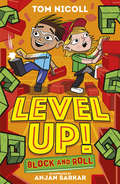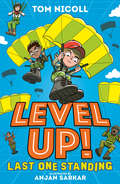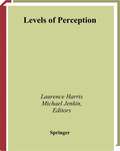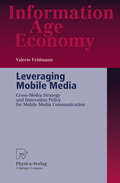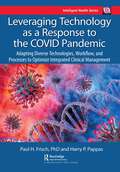- Table View
- List View
A Level Chemistry A For OCR Year 2 Student Book (PDF)
by Rob Ritchie Dave GentWritten by curriculum and specification experts, this Student Book supports and extends students through the new course while delivering the breadth, depth, and skills needed to succeed in the new A Level and beyond. It develops true subject knowledge while also developing essential exam skills.
A Level Chemistry for OCR A Student Book
by Rob Ritchie Dave GentWritten by curriculum and specification experts, this Student Book supports and extends students through the new linear course while delivering the breadth, depth, and skills needed to succeed in the new A Levels and beyond. It develops true subject knowledge while also developing essential exam skills.
Level Doubling Network and Ripple Correlation Control MPPT Algorithm for Grid-Connected Photovoltaic Systems (Springer Theses)
by Manel HammamiThis book describes an original improvement in power quality of photovoltaic generation systems obtained by the use of a multilevel inverter implemented with level doubling network (LDN). Modulation principles and harmonic analysis of output voltages are proposed and introduced in detail for both single and three-phase LDN configurations. The analysis is then extended to dc-link current and voltage, with emphasis to low-frequency harmonics and switching frequency ripple. This work represents the first comprehensive implementation of maximum power point tracking (MPPT) schemes using the ripple correlation control (RCC) algorithm in the presence of multiple ripple harmonics, such as in the case of multilevel inverters. Numerical simulations and experimental tests are carefully reported here, together with practical insights into the design of dc-link capacitors.
A Level Further Mathematics For AQA Mechanics Student Book (AS/A Level Further Mathematics AQA Ser. (PDF))
by Stephen Ward Jess Barker Nathan Barker Michele Conway Janet SuchNew 2017 Cambridge A Level Maths and Further Maths resources to help students with learning and revision. Written for the AQA AS/A Level Further Mathematics specification for first teaching from 2017, this print Student Book covers the Mechanics content for AS and A Level. It balances accessible exposition with a wealth of worked examples, exercises and opportunities to test and consolidate learning, providing a clear and structured pathway for progressing through the course. It is underpinned by a strong pedagogical approach, with an emphasis on skills development and the synoptic nature of the course. Includes answers to aid independent study. This book has entered an AQA approval process.
A Level Physics A For Ocr Student Book (PDF)
by Ann Fullick Jo Locke Paul Bircher Graham Bone Gurinder Chadha Nigel SaundersWritten by curriculum and specification experts, this student book supports and extends students through the new linear course while delivering the breadth, depth, and skills needed to succeed in the new A Levels and beyond. Unlike other specification-specific books, this book develops true subject knowledge while developing essential exam skills.
A Level Physics A for OCR Year 1 and AS Student Book (PDF)
by Nigel Saunders Gurinder Chadha Graham BoneWritten by curriculum and specification experts, this Student Book supports and extends students through the new course while delivering the breadth, depth, and skills needed to succeed in the new AS and beyond. It develops true subject knowledge while also developing essential exam skills.
A Level Physics for OCR A: Year 2, Revision Guide (PDF)
by Gurinder ChadhaThe OCR A Level Physics A Revision Guide is fully revised and updated for the new 2015 specification. Exactly matched to the specification, the Revision Guide provides comprehensive, specification-linked content, so you can be sure you are covering everything you need to know for the exams. It is packed with engaging revision and practice material to keep you focused and contains a wealth of exam-style questions to test your knowledge and skills to help you fullyprepare for the exams.
A Level Physics for OCR A: Year 2, Student Book (PDF)
by Gurinder Chadha Graham Bone Nigel SaundersWritten by curriculum and specification experts, this Student Book supports and extends students through the new course while delivering the breadth, depth, and skills needed to succeed in the new AS and beyond. It develops true subject knowledge while also developing essential exam skills.
A Level Physics for OCR A Revision Guide
by Gurinder ChadhaThe OCR A Level Physics A Revision Guide provides comprehensive, specification-matched content, packed with engaging revision and practice material to keep you focused. UK schools save 40% off the RRP! Discount will be automatically applied when you order on your school account.
A Level Salters' Advanced Chemistry for OCR B: Year 1 and AS (4th edition) (PDF)
by Lesley Johnston Dave Newton Frank Harriss Dave Walsstnldge Mark GaleWritten by the University of York project team for Salters' Advanced Chemistry, this Student Book supports and extends students through the new linear course while delivering the breadth, depth, and skills needed to succeed in the new A Levels and beyond. It develops true subject knowledge while also developing essential exam skills. The fourth edition combines the Chemical Storyline and Chemical Ideas into a single, integrated volume for the first time, providingideal support for the new specification.
A Level Salters' Chemistry For Ocr
by University of York StaffThis student book supports and extends students through the new linear course while delivering the breadth, depth, and skills needed to succeed in the new A Levels and beyond. It develops true subject knowledge while also developing essential exam skills.
Level Set Method in Medical Imaging Segmentation
by Ayman El-Baz Jasjit S. SuriLevel set methods are numerical techniques which offer remarkably powerful tools for understanding, analyzing, and computing interface motion in a host of settings. When used for medical imaging analysis and segmentation, the function assigns a label to each pixel or voxel and optimality is defined based on desired imaging properties. This often includes a detection step to extract specific objects via segmentation. This allows for the segmentation and analysis problem to be formulated and solved in a principled way based on well-established mathematical theories. Level set method is a great tool for modeling time varying medical images and enhancement of numerical computations.
Level Set Method in Medical Imaging Segmentation
by Ayman El-Baz Jasjit S. SuriLevel set methods are numerical techniques which offer remarkably powerful tools for understanding, analyzing, and computing interface motion in a host of settings. When used for medical imaging analysis and segmentation, the function assigns a label to each pixel or voxel and optimality is defined based on desired imaging properties. This often includes a detection step to extract specific objects via segmentation. This allows for the segmentation and analysis problem to be formulated and solved in a principled way based on well-established mathematical theories. Level set method is a great tool for modeling time varying medical images and enhancement of numerical computations.
Level Set Methods and Dynamic Implicit Surfaces (Applied Mathematical Sciences #153)
by Stanley Osher Ronald FedkiwVery hot area with a wide range of applications; Gives complete numerical analysis and recipes, which will enable readers to quickly apply the techniques to real problems; Includes two new techniques pioneered by Osher and Fedkiw; Osher and Fedkiw are internationally well-known researchers in this area
Level Set Methods for Fluid-Structure Interaction (Applied Mathematical Sciences #210)
by Georges-Henri Cottet Emmanuel Maitre Thomas MilcentThis monograph is devoted to Eulerian models for fluid-structure interaction by applying the original point of view of level set methods.In the last 15 years, Eulerian models have become popular tools for studying fluid-structure interaction problems. One major advantage compared to more conventional methods such as ALE methods is that they allow the use of a single grid and a single discretization method for the different media. Level set methods in addition provide a general framework to follow the fluid-solid interfaces, to represent the elastic stresses of solids, and to model the contact forces between solids.This book offers a combination of mathematical modeling, aspects of numerical analysis, elementary codes and numerical illustrations, providing the reader with insights into the applications and performance of these models.Assuming background at the level of a Master’s degree, Level Set Methods for Fluid-Structure Interaction provides researchers in the fields of numerical analysis of PDEs, theoretical and computational mechanics with a basic reference on the topic. Its pedagogical style and organization make it particularly suitable for graduate students and young researchers.
Level Up: Block and Roll (Level Up #2)
by Tom NicollVideogame-obsessed Flo and her best friend, Max, get more than they bargained for when they find themselves INSIDE their favourite games! Having successfully battled spaceships, Max and Flo are excited to return home. But when they wake up, they’re in Max’s favourite game, Blocktopia. The friends are accepted into a city, where they are protected from the dangerous monsters that attack daily. Max is in his element – creating increasingly elaborate buildings – but Flo just wants to go home. Then she uncovers a secret. A secret which might just be the key to escaping the game… From the award-winning author of BOYBAND OF THE APOCALYPSE comes a laugh-out-loud adventure with a technological twist, perfect for fans of I SWAPPED MY BROTHER ON THE INTERNET, David Baddiel, Minecraft and Fortnite. Praise for LEVEL UP: 'The fast paced action and likeable characters ensure that LEVEL UP has the potential to be a 'hook book' for many young readers.’ – ReadingZone
Level Up: Last One Standing (Level Up)
by Tom NicollVideogame-obsessed Flo and her best friend, Max, get more than they bargained for when they find themselves INSIDE their favourite games! Crammed on a plane flying over the dramatic landscape of Last to Leave, Flo and Max get a shock as they are suddenly parachuted out. The game has begun! As they navigate challenging terrain and highly skilled players, they come face to face with an old enemy. With time running out, the friends have to decide who they can trust if they’re going to make it to the end. Can they complete the game and get back home? From the award-winning author of BOYBAND OF THE APOCALYPSE comes a laugh-out-loud adventure with a technological twist, perfect for fans of I SWAPPED MY BROTHER ON THE INTERNET, David Baddiel, Pokemon and Fortnite. Praise for LEVEL UP: 'The fast paced action and likeable characters ensure that LEVEL UP has the potential to be a 'hook book' for many young readers’ – Reading Zone 'Fast-paced with oodles of reluctant reader appeal' – The Bookseller
Levels of Perception
by Laurence Harris Michael JenkinIn this book the authors relate and discuss the idea that perceptual processes can be considered at many levels. A phenomenon that appears at one level may not be the same as a superficially similar phenomenon that appears at a different level. For example "induced motion" can be analyzed in terms of eye movements or at the retinal level or at a much higher cognitive level: how do these analyses fit together? The concept of levels also makes us think of the flow of information between levels, which leads to a consideration of the roles of top-down and bottom-up (or feed-forward, feed-back) flow. There are sections devoted to vestibular processing, eye movement processing and processing during brightness perception. The final section covers levels of processing in spatial vision. All scientists and graduate students working in vision will be interested in this book as well as people involved in using visual processes in computer animations, display design or the sensory systems of machines.
Levels of Reality in Science and Philosophy: Re-examining the Multi-level Structure of Reality (Jerusalem Studies in Philosophy and History of Science)
by Stavros Ioannidis Gal Vishne Meir Hemmo Orly ShenkerThis book offers a unique perspective on one of the deepest questions about the world we live in: is reality multi-leveled, or can everything be reduced to some fundamental ‘flat’ level? This deep philosophical issue has widespread implications in philosophy, since it is fundamental to how we understand the world and the basic entities in it. Both the notion of ‘levels’ within science and their ontological implications are issues that are underexplored in the philosophical literature. The volume reconsiders the view that reality contains many levels and opens new ways to understand the ontological status of the special sciences. The book focuses on major open questions that arise at the foundations of cognitive science, cognitive psychology, brain science and other special sciences, in particular with respect to the physical foundations of these sciences. For example: Is the mental computational? Do brains compute? How can the special sciences be autonomous from physics, grounded in, or based on, physics and at the same time irreducible to physics? The book is an important read for scientists and philosophers alike. It is of interest to philosophers of science, philosophers of mind and biology interested in the notion of levels, but also to psychologists, cognitive scientists and neuroscientists investigating such issues as the precise relation of the mental to the underlying neural structures and the appropriate approach to study it.
Levels of Selection in Evolution
by Laurent KellerEver since the groundbreaking work of George Williams, W. D. Hamilton, and Richard Dawkins, evolutionary biologists have recognized that natural selection generally does not operate for the good of the group, but rather for the good of lower-level units such as the individual, the cell, even the gene. One of the fundamental problems of biology is: what keeps competition between these various levels of natural selection from destroying the common interests to be gained from cooperation? In this volume twelve prominent scientists explore this question, presenting a comprehensive survey of the current theoretical and empirical research in evolutionary biology. Recent studies show that at many levels of biological organization, mechanisms have evolved to prevent potential conflict in natural selection. Editor Laurent Keller's aim in this book is to bring together leading researchers from all biological disciplines to outline these potential conflicts and discuss how they are resolved. A multi-level approach of this kind allows important insights into the evolution of life, as well as bridging the long-standing conceptual chasm between molecular and organismal biologists. The chapters here follow a rigorous theoretical framework, giving the book an overall synergy that is unique to multi-authored books. The contributors, in addition to the editor, are H. Charles J. Godfray, Edward Allen Herre, Dawn M. Kitchen, Egbert Giles Leigh, Jr., Catherine M. Lessells, Richard E. Michod, Leonard Nunney, Craig Packer, Andrew Pomiankowski, H. Kern Reeve, John Maynard Smith, and Eörs Szathmáry.
Levels of Selection in Evolution (Monographs in Behavior and Ecology #66)
by Laurent KellerEver since the groundbreaking work of George Williams, W. D. Hamilton, and Richard Dawkins, evolutionary biologists have recognized that natural selection generally does not operate for the good of the group, but rather for the good of lower-level units such as the individual, the cell, even the gene. One of the fundamental problems of biology is: what keeps competition between these various levels of natural selection from destroying the common interests to be gained from cooperation? In this volume twelve prominent scientists explore this question, presenting a comprehensive survey of the current theoretical and empirical research in evolutionary biology. Recent studies show that at many levels of biological organization, mechanisms have evolved to prevent potential conflict in natural selection. Editor Laurent Keller's aim in this book is to bring together leading researchers from all biological disciplines to outline these potential conflicts and discuss how they are resolved. A multi-level approach of this kind allows important insights into the evolution of life, as well as bridging the long-standing conceptual chasm between molecular and organismal biologists. The chapters here follow a rigorous theoretical framework, giving the book an overall synergy that is unique to multi-authored books. The contributors, in addition to the editor, are H. Charles J. Godfray, Edward Allen Herre, Dawn M. Kitchen, Egbert Giles Leigh, Jr., Catherine M. Lessells, Richard E. Michod, Leonard Nunney, Craig Packer, Andrew Pomiankowski, H. Kern Reeve, John Maynard Smith, and Eörs Szathmáry.
Leveraging Mobile Media: Cross-Media Strategy and Innovation Policy for Mobile Media Communication (Information Age Economy)
by Valerie FeldmannMobile communications and next generation wireless networks emerge as new distribution channels for the media. This development offers exciting new opportunities for media companies: the mobile communication system creates new usage contexts for media content and services; the social use of mobile communications suggests that identity representation in social networks, impulsive access to trusted media brands, and micro-coordination emerge as new sources of value creation in the media industries. In the light of this background, this book takes two different viewpoints on the development of mobile media: from a competitive strategy point of view it analyzes the extension of cross-media strategies and the emergence of cross-network strategies; from a public policy point of view it develops demands and requirements for an innovation policy that fosters innovation in mobile media markets.
Leveraging Technology as a Response to the COVID Pandemic: Adapting Diverse Technologies, Workflow, and Processes to Optimize Integrated Clinical Management (Intelligent Health Series)
by Harry P. Pappas Paul H. FrischIn 2019 the world was struck with the Coronavirus (COVID-19) infecting major portions of the world’s population. There were no vaccines or treatments available to help mitigate the disease or offer a cure. The world's health systems were inundated with massive numbers of patients with varying ranges of symptoms, acuity, and levels of criticality. The world's healthcare organizations soon found themselves in an unmanageable situation, directly impacting the ability to manage patients across the entire healthcare environment. Most healthcare institutions had plans for emergency preparedness and procedures to deal with temporary crises, none of which were effective against the impact of COVID-19. COVID-19 was a highly contagious disease, resulting in high volumes of admissions with long lengths of stay. The virus quickly overwhelmed institutions with large patient volumes, resulting in shortages of patient beds, medical equipment, personal protective devices, cleaning agents, and other critical supplies. Hospital operations were further impacted by staff shortages due to exposure, resulting contagion, the shutdown of transit systems, and responsibilities at home due to school and business closures. This timely and important book describes the impact on the hospital ability to provide patient care and how healthcare institutions leveraged diverse technology solutions to combat the impact of COVID-19 on providing patient care. The authors also discuss implementation of these technology solutions and the many lessons learned of how healthcare institutions can enhance their emergency preparedness in the future from the COVID experience. The authors would like to acknowledge, thank, and dedicate this book to the hundreds of thousands of healthcare workers around the world who spent countless hours and put their own lives and families lives at risk to help patients though this pandemic.
Leveraging Technology as a Response to the COVID Pandemic: Adapting Diverse Technologies, Workflow, and Processes to Optimize Integrated Clinical Management (Intelligent Health Series)
by Harry P. Pappas Paul H. FrischIn 2019 the world was struck with the Coronavirus (COVID-19) infecting major portions of the world’s population. There were no vaccines or treatments available to help mitigate the disease or offer a cure. The world's health systems were inundated with massive numbers of patients with varying ranges of symptoms, acuity, and levels of criticality. The world's healthcare organizations soon found themselves in an unmanageable situation, directly impacting the ability to manage patients across the entire healthcare environment. Most healthcare institutions had plans for emergency preparedness and procedures to deal with temporary crises, none of which were effective against the impact of COVID-19. COVID-19 was a highly contagious disease, resulting in high volumes of admissions with long lengths of stay. The virus quickly overwhelmed institutions with large patient volumes, resulting in shortages of patient beds, medical equipment, personal protective devices, cleaning agents, and other critical supplies. Hospital operations were further impacted by staff shortages due to exposure, resulting contagion, the shutdown of transit systems, and responsibilities at home due to school and business closures. This timely and important book describes the impact on the hospital ability to provide patient care and how healthcare institutions leveraged diverse technology solutions to combat the impact of COVID-19 on providing patient care. The authors also discuss implementation of these technology solutions and the many lessons learned of how healthcare institutions can enhance their emergency preparedness in the future from the COVID experience. The authors would like to acknowledge, thank, and dedicate this book to the hundreds of thousands of healthcare workers around the world who spent countless hours and put their own lives and families lives at risk to help patients though this pandemic.
Leviathan
by Philip HoareThis edition does not include illustrations. The story of a man’s obsession with whales, which takes him on a personal, historical and biographical journey – from his childhood to his fascination with Moby-Dick and his excursions whale-watching.



